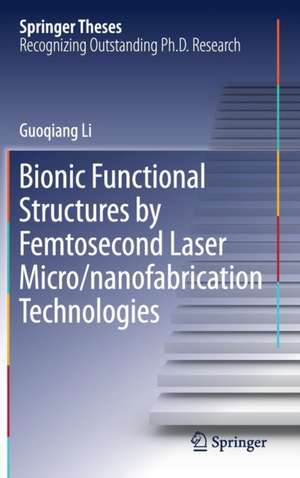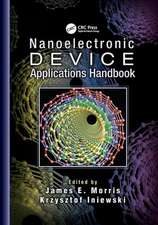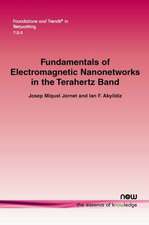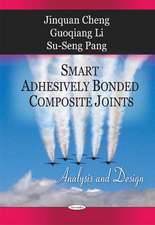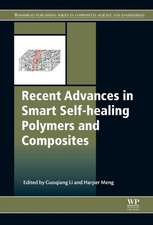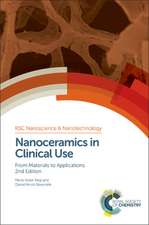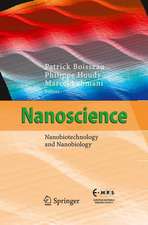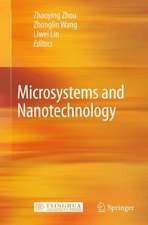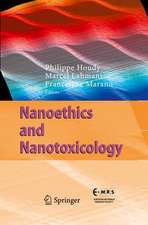Bionic Functional Structures by Femtosecond Laser Micro/nanofabrication Technologies: Springer Theses
Autor Guoqiang Lien Limba Engleză Hardback – 28 mai 2018
| Toate formatele și edițiile | Preț | Express |
|---|---|---|
| Paperback (1) | 633.02 lei 6-8 săpt. | |
| Springer Nature Singapore – 4 ian 2019 | 633.02 lei 6-8 săpt. | |
| Hardback (1) | 639.08 lei 6-8 săpt. | |
| Springer Nature Singapore – 28 mai 2018 | 639.08 lei 6-8 săpt. |
Din seria Springer Theses
- 18%
 Preț: 997.88 lei
Preț: 997.88 lei -
 Preț: 389.88 lei
Preț: 389.88 lei - 15%
 Preț: 646.94 lei
Preț: 646.94 lei - 18%
 Preț: 943.43 lei
Preț: 943.43 lei -
 Preț: 399.29 lei
Preț: 399.29 lei - 18%
 Preț: 944.99 lei
Preț: 944.99 lei - 15%
 Preț: 636.80 lei
Preț: 636.80 lei - 18%
 Preț: 941.05 lei
Preț: 941.05 lei - 15%
 Preț: 643.16 lei
Preț: 643.16 lei - 15%
 Preț: 642.68 lei
Preț: 642.68 lei - 18%
 Preț: 1103.62 lei
Preț: 1103.62 lei - 20%
 Preț: 558.83 lei
Preț: 558.83 lei - 18%
 Preț: 1112.30 lei
Preț: 1112.30 lei - 18%
 Preț: 944.19 lei
Preț: 944.19 lei - 18%
 Preț: 1109.92 lei
Preț: 1109.92 lei - 18%
 Preț: 1217.27 lei
Preț: 1217.27 lei - 15%
 Preț: 640.06 lei
Preț: 640.06 lei - 15%
 Preț: 636.45 lei
Preț: 636.45 lei - 15%
 Preț: 640.06 lei
Preț: 640.06 lei - 15%
 Preț: 640.88 lei
Preț: 640.88 lei -
 Preț: 389.70 lei
Preț: 389.70 lei - 20%
 Preț: 563.91 lei
Preț: 563.91 lei -
 Preț: 393.35 lei
Preț: 393.35 lei - 15%
 Preț: 637.93 lei
Preț: 637.93 lei - 15%
 Preț: 641.85 lei
Preț: 641.85 lei - 18%
 Preț: 1225.94 lei
Preț: 1225.94 lei - 20%
 Preț: 551.36 lei
Preț: 551.36 lei - 18%
 Preț: 1229.10 lei
Preț: 1229.10 lei - 15%
 Preț: 639.25 lei
Preț: 639.25 lei - 18%
 Preț: 999.45 lei
Preț: 999.45 lei - 15%
 Preț: 640.06 lei
Preț: 640.06 lei - 18%
 Preț: 1220.45 lei
Preț: 1220.45 lei - 18%
 Preț: 1116.26 lei
Preț: 1116.26 lei - 18%
 Preț: 1110.72 lei
Preț: 1110.72 lei - 18%
 Preț: 1000.87 lei
Preț: 1000.87 lei - 18%
 Preț: 891.17 lei
Preț: 891.17 lei - 15%
 Preț: 640.06 lei
Preț: 640.06 lei - 5%
 Preț: 1154.07 lei
Preț: 1154.07 lei - 15%
 Preț: 635.96 lei
Preț: 635.96 lei - 15%
 Preț: 640.88 lei
Preț: 640.88 lei -
 Preț: 387.20 lei
Preț: 387.20 lei - 18%
 Preț: 1109.92 lei
Preț: 1109.92 lei -
 Preț: 385.25 lei
Preț: 385.25 lei -
 Preț: 385.25 lei
Preț: 385.25 lei - 18%
 Preț: 1112.30 lei
Preț: 1112.30 lei - 18%
 Preț: 999.45 lei
Preț: 999.45 lei -
 Preț: 386.99 lei
Preț: 386.99 lei - 15%
 Preț: 637.13 lei
Preț: 637.13 lei - 20%
 Preț: 554.21 lei
Preț: 554.21 lei - 20%
 Preț: 555.59 lei
Preț: 555.59 lei
Preț: 639.08 lei
Preț vechi: 751.86 lei
-15% Nou
Puncte Express: 959
Preț estimativ în valută:
122.30€ • 127.22$ • 100.97£
122.30€ • 127.22$ • 100.97£
Carte tipărită la comandă
Livrare economică 14-28 aprilie
Preluare comenzi: 021 569.72.76
Specificații
ISBN-13: 9789811303586
ISBN-10: 9811303584
Pagini: 126
Ilustrații: XV, 128 p. 115 illus., 84 illus. in color.
Dimensiuni: 155 x 235 mm
Greutate: 0.38 kg
Ediția:1st ed. 2018
Editura: Springer Nature Singapore
Colecția Springer
Seria Springer Theses
Locul publicării:Singapore, Singapore
ISBN-10: 9811303584
Pagini: 126
Ilustrații: XV, 128 p. 115 illus., 84 illus. in color.
Dimensiuni: 155 x 235 mm
Greutate: 0.38 kg
Ediția:1st ed. 2018
Editura: Springer Nature Singapore
Colecția Springer
Seria Springer Theses
Locul publicării:Singapore, Singapore
Cuprins
Introduction.- Key technological of bionic structure surfaces induced by femtosecond laser.- Bionic structure induced by femtosecond laser.- PDMS surface wetting based on metal template by femtosecond laser.- Three-dimensional porous metal micro/nano cage structure by femtosecond laser with ethanol assisted.- Superhydrophilic/ underwater superoleophobic microcone arrays by sucrose solution assisted femtosecond laser.- Conclusion and Outlook.
Notă biografică
Previous degrees:
June 2011 South University of Science and Technology, China
M.S., Physics, major field in laser micro/nanofabrication
June 2008 South University of Science and Technology, China
B.S., Optical Information Science and Technology, major field in laser principles & technology
Area of work:
Femtosecond laser interactions with materials.
Femtosecond laser micro/nanofabrication. Bio-inspired function structures and their applications.
Honors:
First-class scholarship offered by China Aerospace Science and Technology Corporation, (2014).
Chinese Academy of Sciences Dean Awarding offered by Chinese Academy of Sciences, (2015).
Excellent Doctoral Dissertations offered by Chinese Academy of Sciences, (2016).
June 2011 South University of Science and Technology, China
M.S., Physics, major field in laser micro/nanofabrication
June 2008 South University of Science and Technology, China
B.S., Optical Information Science and Technology, major field in laser principles & technology
Area of work:
Femtosecond laser interactions with materials.
Femtosecond laser micro/nanofabrication. Bio-inspired function structures and their applications.
Honors:
First-class scholarship offered by China Aerospace Science and Technology Corporation, (2014).
Chinese Academy of Sciences Dean Awarding offered by Chinese Academy of Sciences, (2015).
Excellent Doctoral Dissertations offered by Chinese Academy of Sciences, (2016).
Textul de pe ultima copertă
This thesis combines advanced femtosecond laser micro/nanofabrication technologies and frontier bionic design principles to prepare diverse biomimetic micro/nanostructures to realize their functions. By studying the formation mechanism of the micro/nanostructures, the author identifies various artificial structural colors, three-dimensional micro/nanocage arrays, and fish-scale inspired microcone arrays in different processing environments. Multiple functions such as enhanced antireflection, hydrophobicity, and underwater superoleophobicity are achieved by precisely adjusting laser-machining parameters. This novel design and method have extensive potential applications in the context of new colorizing technologies, microfluidics, microsensors, and biomedicine.
Caracteristici
Nominated as an outstanding Ph.D. thesis by the University of Science and Technology of China Develops a model for the relationship between the laser parameters and the induced micro/nanostructures by combining femtosecond laser micro-/nano-machining technology and bionic design principles Studies the formation mechanism of structural colors, hydrophobic surfaces, and underwater superoleophobic surfaces Discusses the controllability of the laser-induced micro/nanostructures, and verifies the functions experimentally
